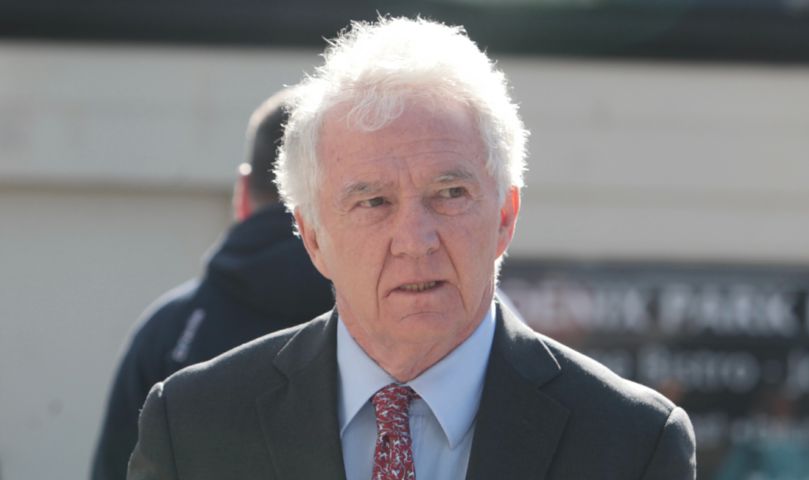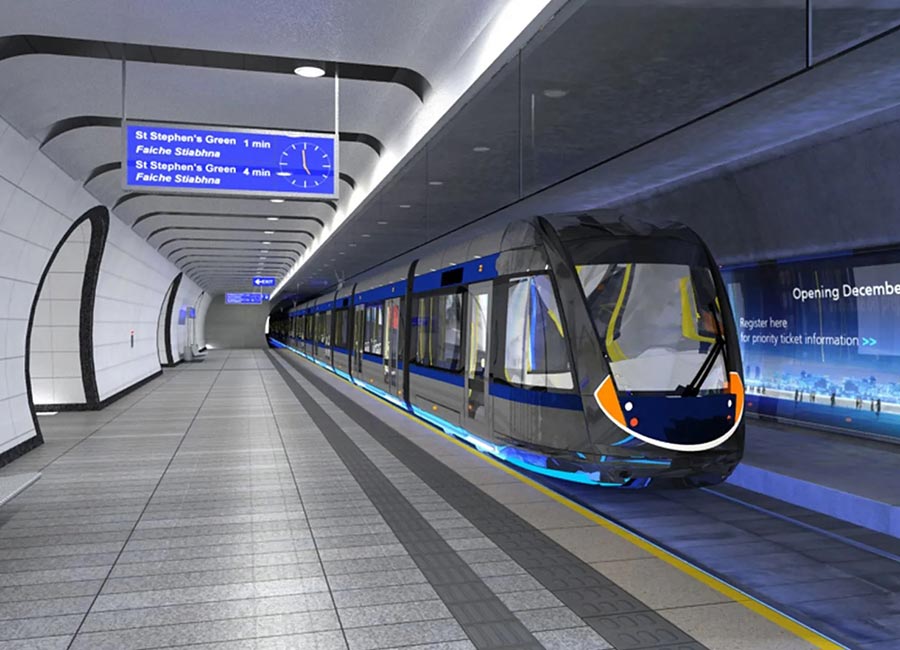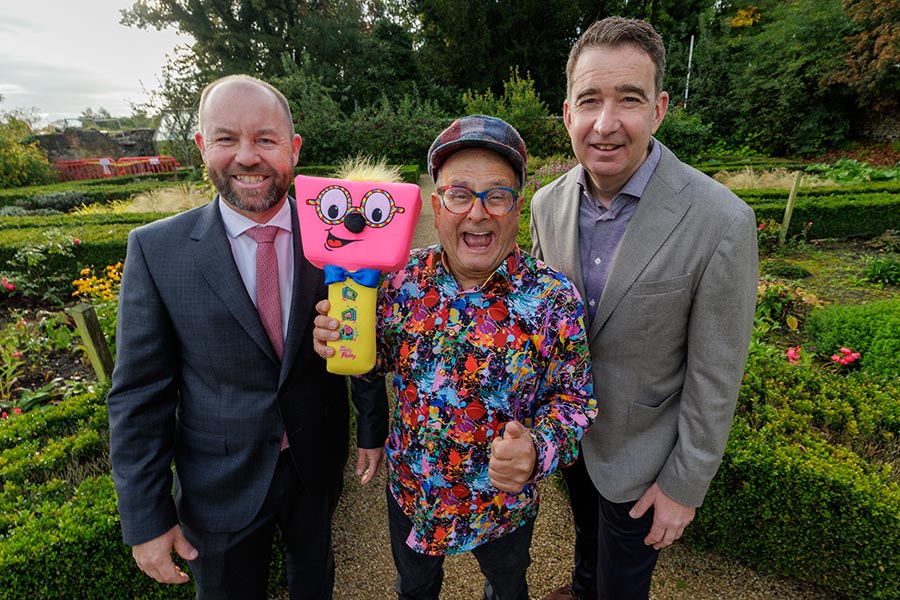Sean FitzPatrick has died at the age of 73 after a heart attack last week. When he stepped down as chief executive of Anglo Irish Bank in 2005, Sean FitzPatrick was a very rich man. Then he embarked on an investment splurge that ended in ruin. In this Business Plus article published in February 2011, Nick Mulcahy delved into The Fitzpatrick Tapes to find out what went wrong
Why did Anglo Irish Bank go bust? The immediate cause was the tightening of liquidity in global credit markets in 2008. The credit crunch brought into sharp focus the quality of Anglo’s property-related loan book, which turned out to be worth a lot less than it appeared in the balance sheet of Anglo’s annual financial statements.
Another reason why so many of the loans have turned out to be impaired is that the bank’s driving force, Sean FitzPatrick, had a very cavalier attitude to risk.
The extent of FitzPatrick’s personal risk-taking is laid bare in The Fitzpatrick Tapes, a book by financial journalists Tom Lyons and Brian Carey based on interviews with FitzPatrick. The book contains extraordinary detail of FitzPatrick’s personal investments, both when he was running the bank and from 2005 onwards, after FitzPatrick nominally handed over control of Anglo to David Drumm.
In his role as chairman, FitzPatrick exploited his relationship with the bank by ramping up his personal borrowings from Anglo to fund a series of madcap investments that resulted in a cash pile of €50m dwindling to nothing in a period of five years.
The price FitzPatrick paid for his folly is personal bankruptcy, as well as widespread public odium and contempt. For years FitzPatrick hid his personal borrowings from Anglo by warehousing the loans with Irish Nationwide Building Society before the bank’s financial year-end.
By doing so, FitzPatrick conned bank investors, insofar as that if shareholders had been aware that the bank’s main man was taking huge personal risks with commercial investments, then they might have chosen to invest their money elsewhere.
At the peak in 2007, FitzPatrick’s borrowings from Anglo amounted to €122m. The annual report that year stated that director loans spread across 13 directors amounted to €41m. But what did FitzPatrick do with all this money, and how come he came up so short when the loans were called in that his only option was bankruptcy?
The Player
The chapter in The Fitzpatrick Tapes that details FitzPatrick’s investment activities is called ‘The Player’. The picture that emerges is of an individual who really would have been happier running a hedge fund than a bank.
Yet FitzPatrick insists that he didn’t want to be a player just to accumulate more wealth. He related to the authors: “I had no ambition to become the richest man in Ireland. The difference between me having €50m and €500m made no sense to me. Would I have liked €500m? Of course I would. So would I aim to that? No, that wasn’t there.”
Fitzpatrick started his banking career with Irish Bank of Commerce in April 1974, when he was 25-years-old. Six months later IBC was subsumed into City of Dublin Bank and in 1980 IBC purchased Anglo Irish Bank, a cross between a leasing house and a merchant bank.
In 1986, City of Dublin Bank and IBC/Anglo merged into a new single entity called Anglo Irish Bank Corporation plc and FitzPatrick, aged 38, was put in charge.
FitzPatrick was on the banking treadmill for thirty years before he stepped down as Anglo’s chief executive in January 2005. Fitzpatrick told Tom Lyons: “I wanted to change my life, to cut loose and have a bit of fun. I was down in the bank 24/7 in different ways. I was coming in early and going home late, meeting guys at seven o’clock for breakfast, meeting with junior people. I was just going non-stop. It was my whole life, everything. I just sold all the time. When I was out with people I was talking about the bank.
“What did I want in life? Did I want to end up dying with €50m to pass to my kids? No, I didn’t. I was no longer in the bank so I was free to do what I wanted to do. I would invest here, there and everywhere. I would put €2m or €3m into this or that. I was not trying to increase wealth and I was not trying to spend it. I was just doing what I was doing. It sounds terrible but that is the honest view.”
Property Syndicates
According to The Fitzpatrick Tapes, FitzPatrick was an active investor through the 1990s, though on a much smaller scale than what was to follow. In 1996, he invested in the two property syndicates, borrowing €1.4m from Anglo. Such borrowings seem to have been the first occasion when FitzPatrick had to decide what he would or would not disclose under the directors’ loans section of the annual report.
In the book, Fitzpatrick explains: “I had a particular percentage in a partnership and in some cases Anglo had provided the main funding to the partnerships. So the question arose as to what figure should be used for me.
“For example, say the bank lent €4m to a property partnership and the partners contributed €1m in cash, of which my share was 20%, or €200,000. Let’s assume that all the partners were jointly and severally liable. What is disclosed in the financial statements? Is it the €200,000 that the bank lent to me directly, or is it €200,000 plus €800,000? Or is it €200,000 plus €4m, which is the total of the loan?”
Technically, €4.2m is the appropriate figure as FitzPatrick could be liable for that amount if the value of the property fell to zero and the rest of the syndicate reneged on repayment. However FitzPatrick took the view that his exposure in this hypothetical deal was just €200,000.
Lyons and Carey comment: “It was of course open to FitzPatrick to make a full disclosure as to the nature of his borrowings, to fully explain why the loan figure was so large. He could have told the shareholders, in a footnote to Anglo’s accounts, that the reason why his personal borrowings were so high was because he was an investor in various property syndicates. Or he could simply have funded his personal investments by borrowing from other banks, as lot of other bank directors did.”
As the loans mounted up, FitzPatrick decided to make the accounting and disclosure dilemmas go away by transferring his loans to Irish Nationwide for a short period around Anglo’s year-end so that the bank’s auditors, Ernst & Young, would not have to include the loans in the annual accounts.
In the book, FitzPatrick insisted to Tom Lyons that he did not come up with the idea but that he allowed it to happen, and he was assured internally that it was all above board. “That appeared to be the best and simplest way of dealing with the accounting problem of investing in property syndicates, so as not to give an exaggerated figure of my indebtedness,” said FitzPatrick.
According to Lyons and Carey, the warehousing procedure was not a secret in Anglo. When the loans were reviewed after FitzPatrick’s resignation as chairman, it emerged that over 20 Anglo employees had signed off on or processed in some way the Irish Nationwide warehousing arrangement over a period of eleven years.
Initially, FitzPatrick’s non-syndicate borrowings were declared in the bank’s annual accounts. But having crossed the Rubicon of avoiding disclosure, it was a small step for FitzPatrick to start warehousing non-syndicate borrowings too.
According to The Fitzpatrick Tapes, in 2001 for the first time FitzPatrick sent a loan relating to a family property investment over to Irish Nationwide, and in 2003 the same happened with €6m borrowed from Anglo to buy apartments and houses for family members in Dublin, London and America.
By 2003, the total being transferred to Irish Nationwide in the annual ‘bed and breakfast’ arrangement amounted to €15m. Fitzpatrick invested c.€5.5m into various property syndicates, €1m in an apartment development in Barbados, and €4.4m in shares of companies other than Anglo.
While in charge of the bank, he also purchased a 10% stake in the syndicate that bought the DHL building at Dublin Airport, and he invested €250,000 in a Cape Town commercial development led by Howard Holdings. In 2004, FitzPatrick put €2.25m into a golf resort development in Hungary.
In FitzPatrick’s words, these and other investments made prior to his stepping down as Anglo chief executive were ‘Mickey Mouse stuff’. His investment firepower was boosted in 2003 when he sold two million Anglo Irish shares, netting around €25m. After that sale, FitzPatrick still had another 1.9 million shares in the bank, valued at €29m. His pension fund had a value of €25m and FitzPatrick moved this into an Approved Retirement Fund, giving him investment control.
In the book, he ruefully recalls: “You can call it unlucky, you can call it foolhardy, you can call it mistaken. Looking back at it now, there I was in a situation where I had €27m on deposit in 2004. There was very little leverage by me before that. Then it really got going after I resigned.”
Riviera Villa
As an example of Fitzpatrick’s freewheeling investment style after handing over to Drumm, The Fitzpatrick Tapes relates the story of a villa in Cap Ferrat in the south of France.
The villa’s price was €11.5m and it required further investment of €3m to get in gold taps, nice baths, ‘all the fancy stuff for the Russians’. And where did the loan come from? Anglo Irish of course. In the event, the villa proved difficult to rent never mind sell, and Anglo was left holding the baby.
The reason FitzPatrick was able to be so carefree with his investments is that Anglo was like a personal piggy bank. Between 2005 and 2009, the scale of his borrowings rocketed almost fourfold from €27m to over €120m.
Lar Bradshaw, a friend of FitzPatrick's, ran a venture capital vehicle called Cove Capital. Through Cove, FitzPatrick invested in Great Irish Pubs, which had a chain of Irish-themed bars in Florida; Clear power, a green energy company; Fresh Mortgages, a sub-prime lender; and a Belgian company that developed a non-sugar sweetener.
According to The Fitzpatrick Tapes, the Cove investors ran up borrowings of about €18m, owed to Anglo and AIB. FitzPatrick signed a personal guarantee of €10m in relation to his Cove investments.
FitzPatrick also invested in Domhnall Slattery’s boutique investment shop, Claret Capital. This was a conduit for pumping $5m into the MBO of Hospital Corporation of America, $3m into a Bermuda re-insurer, $3m into a Merrill Lynch property fund, and $5m into the ill-fated leveraged buyout of Houghton Mifflin and Harcourt Education.
Fitzpatrick also participated in property deals put together by Derek Quinlan, including a hotel in Prague, the Jurys Inn buyout, various European commercial properties, and even Bank of Ireland’s headquarter on Baggot Street.
Other investments detailed in The Fitzpatrick Tapes included a retail shopping mall in Berlin, a chain of UK golf clubs, a riverfront apartment development in Budapest, the leveraged buyout of Alliance Boots, an office block in London, and Eddie O’Connor’s Mainstream Power. FitzPatrick also invested €6m in AIB and Bank of Ireland shares and had stakes in HSBC and Lloyds.
According to Lyons and Carey, despite the volume of deals, Fitzpatrick says he never lost sleep over them. “I was genuinely never worried about them. Why? Because I thought they were going to be OK.” Did he see himself as a financier like Dermot Desmond? “I don’t know what I was doing, is the honest answer. I didn’t see myself as a Dermot Desmond type of guy. I saw myself as a very wealthy guy who had plenty of money.”
Nigerian Oil Well
Out of the myriad of deals, the largest investment related to developing a Nigerian oil well said to hold oil worth over $1 billion. This opportunity came FitzPatrick’s way through Jim O’Driscoll, whose brother Jackie was Sean’s best friend in school. The prospect was controlled by Nigerians who didn’t have the cash to take the project forward. FitzPatrick borrowed $12m from Anglo in a back-to-back loan i.e. the loan was secured on money he held in his deposit account.
For this amount, FitzPatrick, O’Driscoll and Lar Bradshaw got a 20% stake. But the drilling process didn’t run to plan, the price of oil went into reverse and Fitzpatrick’s exposure grew to $20m.
All along the way, the Nigerians proved to be tricky partners, but in 2009 FitzPatrick was still confident that in the long term his oil well stake could get him out of financial jail. Unfortunately for him, there was regime change in Anglo with the appointment of a new chief executive, Australian banker Mike Aynsley. His lieutenant was Tom Hunersen, a straight-talking American.
In November 2009, Hunersen told FitzPatrick that the bank was calling in the oil well loan. The following month, FitzPatrick had talks with the Nigerian partners. He told the authors: “We were offered $20m plus the loan repaid ($40m). I said, No thank you, because we were looking for more. We would have taken it but that was what we were advised to do. Don’t accept the first offer because they are going to come back with some other issues. We believed they were going to get it done.”
Instead, the Nigerians took the offer off the table. Hunersen’s ultimatum to FitzPatrick followed a steady ratcheting up of pressure on the former Anglo boss through 2009. The new regime had started to unravel the security for FitzPatrick’s borrowings and Aynsley didn’t like what he found.
FitzPatrick tried to appease the bank by selling liquid assets. He explained to Tom Lyons: “I was really badly caught out in terms of equities. If Anglo shares hadn’t collapsed below €7 I would have got out.”
FitzPatrick managed to repay €20m, but that still left E70m or more outstanding to Anglo. His problem was that most of his investments were tied up in property. Not only were these assets falling in value and proving impossible to sell – including the Cap Ferrat villa with a price tag of €20m – but some of his syndicate investments were sucking in more cash.
His entire €5m investment in Barry O’Callaghan’s EMG (to whom Anglo had advanced €200m) was wiped out when that company restructured. A $3m investment in a Macau casino realised $168,000.
Hunersen kept up the pressure, telling Fitzpatrick to pay up the oil loan by March 2010, or else. The deadline came and went and the following day Anglo lodged a legal action seeking repayment of €70m. When the suit was reported, a gleeful finance minister Brian Lenihan declared that the nationalised bank would pursue FitzPatrick to “the ends of the earth”.
Restructuring Plan
Accountant Bernard Somers worked out a restructuring plan for FitzPatrick’s finances. In the first week of July 2010, Somers assembled creditors and told them that unsecured creditors faced a shortfall of €47m and could expect a return of about 20 cents in the euro from an asset pool of €12m.
Anglo representatives kept their counsel at the meeting, but later that day Hunsersen hauled FitzPatrick into Anglo’s office and told him the bank wouldn’t cut a deal.
On 12 July 2010, Fitzpatrick filed for bankruptcy to pre-empt any move by the bank. At the hearing on July 26, Anglo claimed it was owed €110m out of total debts of €145m, with available assets of maybe €50m.
Anglo wanted its own nominee in charge of the bankruptcy but when the matter was returned to court in September, the judge appointed Chris Lehane. At the hearing, FitzPatrick gave evidence that his net income was €188 per month. Seven years earlier he had been earning €7,400 per day.
Looking back on the Cap Ferrat splurge, FitzPatrick admitted to the book authors: “There wasn’t a huge amount of analysis put in. A person came to me and said, I want to buy a property for €11.5m. I said, Where? I bought it sight unseen. I never went down there.
“Look, the reason I am doing this interview is to put across to you the way I operated. Then you can understand what was driving me. You might find it hard to accept. You might say, How can a guy like that build a bank? Or maybe it’s because of a guy like that, the bank is now the way it is. You can come to whatever conclusion. But that is the way I was. That is the way I am. That is me.”










